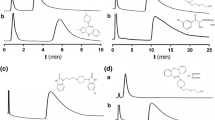Abstract
The binding of [3H](d-ala2,d-leu5)enkephalin (DADLE) to mouse brain membranes was studied via rapid filtration with GF/C filters and via the centrifugation method. The amount of specific binding determined by filtration was found to be dependent on the length of time between the initiation of vacuum and the actual time of filtration. Vacuum strength alone also significantly affected the amount of specifically bound [3H]DADLE measured by filtration. The centrifugation method increased the number of experimentally determined binding sites when compared to the filtration method. The difference in the number of binding sites was only partially attributable to passage of binding material through the GF/C filter. The ability of morphine to displace [3H]DADLE was also found to differ slightly between the two methods. These data indicate that centrifugation is a better method of determining the binding parameters of [3H]DADLE in mouse brain membrane preparations.
Similar content being viewed by others
References
Chang, K. J. andCautrecasas, P. 1979. Multiple opiate receptors: Enkephalins and morphine bind to receptors of different specificity. J. Biol. Chem. 254:2610–2618.
Chang, K. J., Hazum, E., andCautrecasas, P. 1980. Possible role of distinct morphine and enkephalin receptors in mediating the actions of benzomorphan drugs (putative κ and σ agonists). Proc. Natl. Acad. Sci. 77:4469–4473.
Gillan, M. G. C., Kosterlitz, H. W., andPaterson, S. J. 1980. Comparison of the binding characteristics of tritiated opiates and opioid peptides. Br. J. Pharmacol. 70:481–490.
Gillan, M. G. C., andKosterlitz, H. W. 1982. Spectrum of μ, δ and κ binding sites in homogenates of rat brain. Br. J. Pharmacol. 77:461–469.
Hung, C. R., Hong, J. S., andBondy, S. C. 1982. The prevention of an artifact in receptor binding assay by an improved technique. Life Sci. 30:1713–1720.
Kosterlitz, H. W., Paterson, S. S., andRobson, L. E. 1981. Characterization of the κ-subtype of the opiate receptor in the guinea pig brain. Br. J. Pharmacol. 73:939–949.
Munson, P. J., andRodbard, D. 1980. LIGAND: A versatile approach for characterization of ligand binding systems. Anal. Biochem. 107:735–744.
Pfeiffer, A., andHerz, A. 1982. Discrimination of three opiate receptor binding sites with the use of a computerized curve-fitting technique. Mol. Pharmacol. 21:266–271.
Author information
Authors and Affiliations
Rights and permissions
About this article
Cite this article
Barrett, R.W., Vaught, J.L. Comparison of the filtration and centrifugation methods for assaying [3H](d-ala2,d-leu5)enkephalin binding to mouse brain membranes. Neurochem Res 8, 1547–1556 (1983). https://doi.org/10.1007/BF00964156
Accepted:
Issue Date:
DOI: https://doi.org/10.1007/BF00964156




